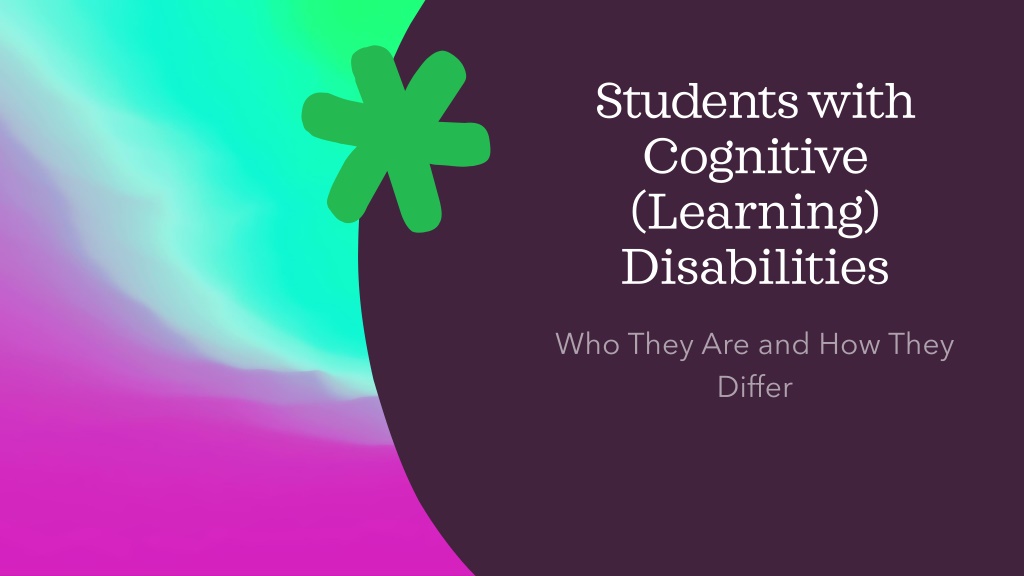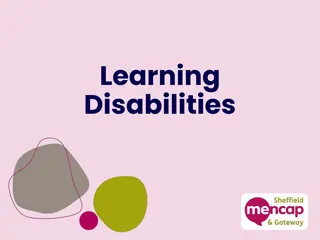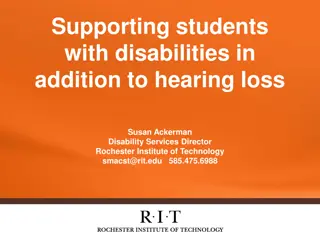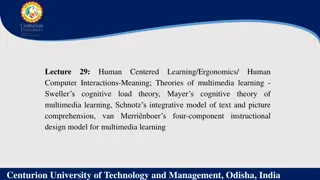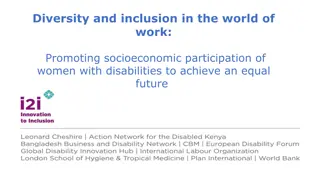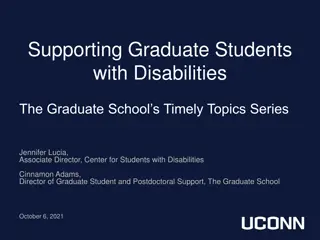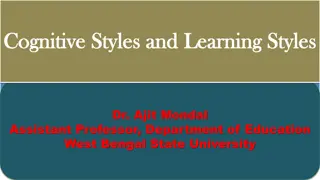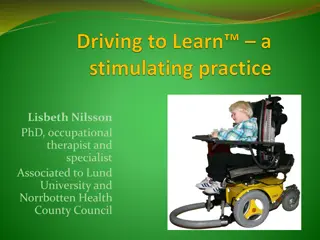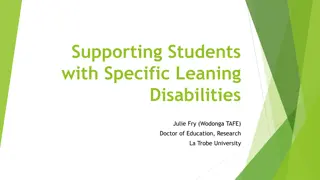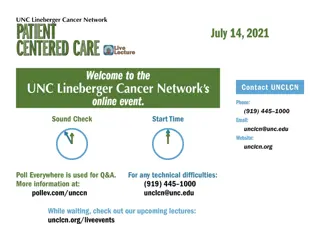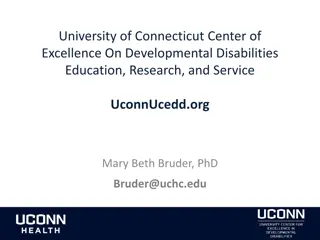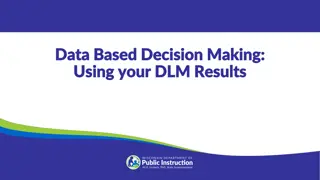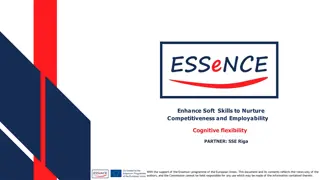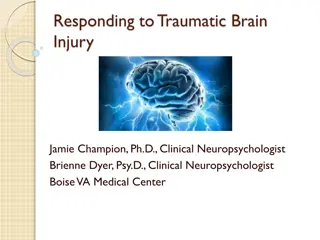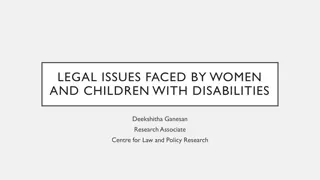Students with Cognitive Learning Disabilities
Students with cognitive learning disabilities encompass a range of conditions such as specific learning disability, intellectual disability, and autism spectrum disorder. These individuals may face challenges in language comprehension, reading, writing, and mathematical calculations. Common disabilities include dyslexia, ADHD, dyscalculia, and processing deficits. Teaching strategies using a structured approach and multi-sensory techniques can help support their learning needs.
Download Presentation

Please find below an Image/Link to download the presentation.
The content on the website is provided AS IS for your information and personal use only. It may not be sold, licensed, or shared on other websites without obtaining consent from the author. Download presentation by click this link. If you encounter any issues during the download, it is possible that the publisher has removed the file from their server.
E N D
Presentation Transcript
Students with Cognitive (Learning) Disabilities
Who They Are Specific Learning Disability Intellectual Disability Autism Spectrum Disorder Twice Exceptional
Specific Learning Disability Have an average to above average IQ (Aptitude) Have lower achievement (> or =to 2 grade levels below) Difficulty understanding or using language, spoken or written May impact listening, thinking, speaking, reading, writing, spelling or doing mathematical calculations. Includes: Dyslexia. Dyslexia is perhaps the best known learning disability. ADHD. Attention Deficit/Hyperactivity Disorder has affected more than 6.4 million children at some point. Dyscalculia. Dysgraphia. Processing Deficits.
Specific Learning Disabilities Poor decoding skills. Poor reading fluency. Poor vocabulary skills Slow reading rate. Difficulty identifying important ideas in context. Lack of self- monitoring reading skills. Poor Extreme difficulty building ideas and images. comprehension and/or retention.
Specific Learning Disabilities Oral comprehension is noticeably stronger than reading comprehension It is difficult for them to control their eyeball movement on the page. Find hard to understand high- frequency words Hard to understand grammar and writing Poor writing skills Difficulty in expressing their thoughts in words. Difficulty in memorizing things and events Difficulty copying from the board Poor Organization skills Poor calculation skills
Specific Learning Disability: Teaching Strategies using a sequential, simultaneous structured multi-sensory approach. learning strategy instruction direct instruction break learning into small steps supply regular, quality feedback administer probes use diagrams, graphics and pictures to augment what they say in words provide ample independent, well- designed intensive practice model instructional practices that they want students to follow engage students in process type questions like How is the strategy working? Where else might you apply it? provide prompts of strategies to use
Intellectual Disability Have Below Average IQ Full scale IQ score of around 70 to 75 indicates a significant limitation in intellectual functioning. Impairments in three areas of adaptive functioning Conceptual language, reading, writing, math, reasoning, knowledge, memory Social empathy, social judgment, communication skills, the ability follow rules and the ability to make and keep friendships Practical independence in areas such as personal care, job responsibilities, managing money, recreation and organizing school and work tasks
Intellectual Disabilties Difficulty understanding new information. Difficulties with communication and social skills. Slow cognitive processing time. Difficulty retaining information Difficulty generalizing information to different situations Trouble understanding social rules. Trouble seeing the results of their actions. Poor problem solving
Intellectual Disabilities: Teaching Strategies Modify teaching to be more hands-on Using small steps Think visual Use baby steps Incorporate more physical learning experiences Start a feedback book or chart Encourage music in the classroom Provide visual stimulus
Autism Spectrum Disorder A broad range of conditions characterized by challenges with social skills, repetitive behaviors, speech and nonverbal communication. Because autism is a spectrum disorder, each person with autism has a distinct set of strengths and challenges. The ways in which people with autism learn, think and problem-solve can range from highly skilled to severely challenged. Often accompanied by sensory sensitivities and medical issues such as gastrointestinal (GI) disorders, seizures or sleep disorders, as well as mental health challenges such as anxiety, depression and attention issues.
Autism Spectrum Disorder Language development Poor nonverbal skills Narrow focus Narrow Interests Attention issues Able to focus acutely on details but may lack the ability to pull back and see the big picture Eye contact and gestures may be difficult Poor ability to read social cues May be both focused and exceptionally skilled in certain areas such as math or music It can be difficult to engage them in other areas of learning Easily distracted by stimulants that barely even register for people who are not autistic They may also find it difficult to focus on information that is outside their range of interest.
Autism Spectrum Disorder Benefit from Pictures modeling the behaviors of others hands-on activities concrete examples Can be twice exceptional gifted and learning disabled Better at processing information when presented visually. Unstructured time or extensive waiting can be difficult for many.
Autism Spectrum Disorder: Teaching Strategies 01 02 03 04 05 06 07 Create an environment that is not over stimulating Create a structured environment with predictable routines Give fewer choices Keep voice low and clear when teaching Use visual representations Make Abstract concepts more concrete Be direct - avoid overuse of language- short, concise, to the point
Twice Exceptional They're called twice-exceptional, or 2e. They have exceptional ability and disability. They are gifted but they also face learning or developmental challenges. Students who are both gifted and challenged can be tough to understand. If they're in a gifted program, they may fall short of expectations.
Twice Exceptional: Teaching Strategies Emphasize strengths Address needs Recognize difference between 2e and gifted underachievers Support social emotional needs Collaborate and communicate
Twice Exceptional: Teaching Strategies Provide Provide choice and multiple ways to respond Link Explicitly link new content to previous learning Teach Teach organizational skills Allow Allow additional time for task completion Help Help to develop self-advocacy Teach Teach stress management skills Use Use assessment data- to determine whether student is 2e or gifted underachiever Provide Provide learning support and/or gifted support Work Work collaboratively to create a balance of activities that offer both challenge and remediation
